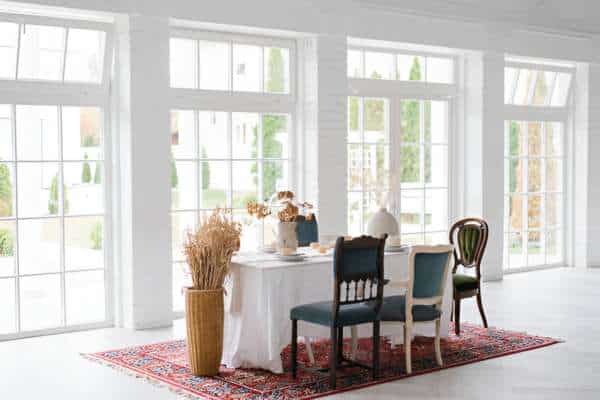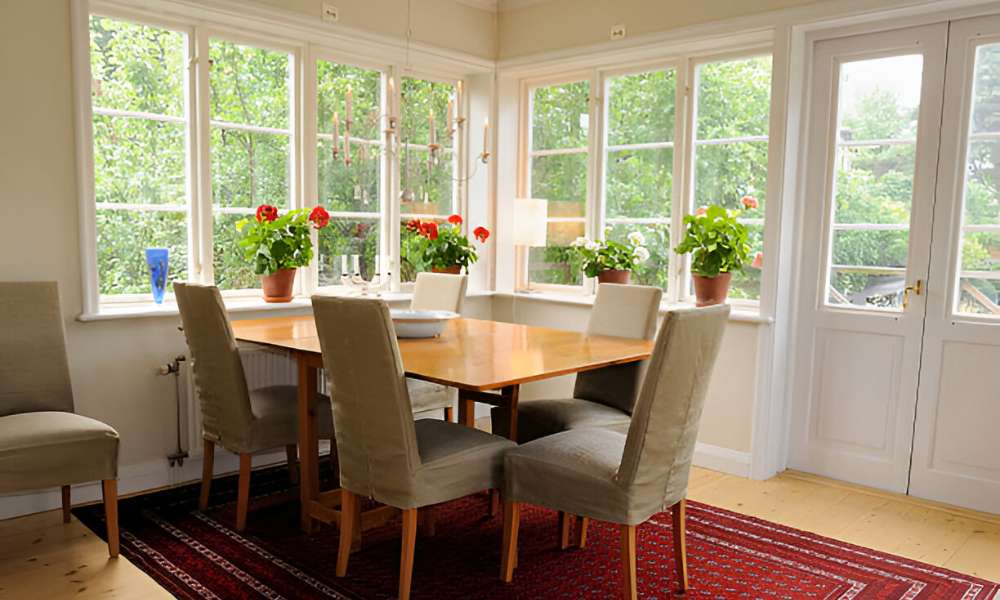Selecting the right rug for your dining table is a key element in designing a functional and aesthetically pleasing dining space. The question of “what size rug for dining table” is crucial, as it impacts not only the visual harmony of the room but also the comfort and practicality during meals. A properly sized rug can define the dining area, protect your flooring, and enhance the overall decor. However, with various table shapes, sizes, and room layouts to consider, finding the perfect fit can be challenging. In this introduction, we will delve into essential guidelines to help you choose a rug that compliments your dining table while creating an inviting atmosphere for family gatherings and entertaining guests.
1. Understanding Rug Size and Dining Table Dimensions

Standard Rug Sizes
Choosing the right size rug for your dining table is crucial for both aesthetic appeal and functionality. Standard rug sizes typically include 6×9, 8×10, and 9×12 feet. These common dimensions are designed to fit various dining table shapes and sizes effectively. For example, a standard 6×9 rug may work well under a small round or square table, while an 8×10 rug is ideal for medium-sized rectangular tables that seat four to six people. If you have a larger dining area or an expansive rectangular table, a 9×12 rug provides ample coverage, ensuring that the entire setup feels cohesive.
Table Dimensions
When considering what size rug for your dining table, it’s essential to understand the typical dimensions of dining tables. Round tables generally range from 36 inches to 60 inches in diameter, making them suitable for smaller rugs like the 6×9 option. Rectangular tables can vary significantly in length; common sizes include those measuring 60 inches long for smaller settings up to over 96 inches for larger gatherings. Square tables usually measure between 36 and 48 inches on each side.
Rug-to-Table Ratio
An important guideline when determining what size rug for dining table setups is the ideal rug-to-table ratio. A general rule of thumb suggests allowing at least 24 to 30 inches of additional space beyond each edge of the table. This extra perimeter ensures that guests can comfortably pull out chairs without risking them sliding off the edge of the carpet onto hard flooring surfaces. For instance, if you have a rectangular table measuring 72 inches long by 36 inches wide, opting for a minimum of an 8×10 rug would provide sufficient coverage while maintaining this necessary clearance.
2. Choosing the Right Rug Size Based on Dining Table Shape

When selecting a rug for your dining table, the shape of the table plays a significant role in determining the appropriate carpet size. Each table shape requires different considerations to create a balanced and aesthetically pleasing eating area.
Rectangular Dining Tables
For rectangular dining tables, choosing the right rug size depends largely on the length of the table. For tables measuring up to 60 inches long, an 8×10 rug is typically ideal, providing enough space around the edges. And for longer tables, such as those between 72 and 96 inches, a 9×12 rug works best to maintain proportion. Balancing both carpet length and width is essential; ensure that there is equal space on either side of the table for visual harmony. A well-sized carpet not only enhances style but also allows for comfortable chair movement.
Round Dining Tables
Round dining tables require specific rug sizes to achieve symmetry and flow in your dining area. For small round tables with diameters up to 48 inches, a 6×6 or an 8-foot round rug can provide adequate coverage while keeping things cozy. Larger round tables (over 54 inches) benefit from an 8-foot or even a 9-foot round rug to maintain proportionate spacing around them. When placing a round carpet under a round table, it’s crucial to ensure that at least two feet of the carpet extends beyond the edge of the table to create visual balance and comfort when pulling out chairs.
Square Dining Tables
Square dining tables generally pair well with square rugs that match their dimensions or slightly exceed them. For example, if you have a square table measuring 42 inches on each side, an area rug size at least 6×6 feet would work nicely. However, it’s important to consider room size—ensure there is adequate space around all sides of the table so that guests can move freely without feeling cramped. An appropriately sized square carpet will enhance symmetry and help define your eating area effectively.
Oval Dining Tables
Oval dining tables present unique challenges when selecting rugs. Suggested sizes for oval tables usually range from an 8×10 to a larger rectangular option like a 9×12, depending on their dimensions. To achieve visual harmony with an oval-shaped setup, consider using an oval carpet that mirrors its shape or opting for a large rectangular one that provides ample coverage while allowing at least two feet beyond each end of the table. This approach ensures that your seating arrangement feels cohesive and inviting while accommodating easy movement around your dining space.
3. Factors to Consider When Selecting Rug Size

When selecting the right rug size for your dining table, several critical factors come into play. Understanding how these elements interact can help you create a harmonious and functional eating space.
Room Size and Shape
The overall size and shape of your dining room significantly impact your rug choice. A large room can accommodate bigger rugs without overwhelming the space, while smaller rooms require more careful consideration. Ideally, the carpet should fit well within the room’s layout, leaving some floor visible around its edges to avoid a cramp feel. For instance, in a narrow or elongated room, opt for a rectangular rug that complements the dimensions of both the table and the space. Ensuring that your carpet enhances rather than dominates the area is key to achieving balance.
Dining Room Furniture Layout
In addition to considering just the dining table, it’s essential to factor in other furniture pieces like sideboards or buffets when selecting a rug size. The carpet should coordinate with all elements in the eating room setup to create an integrated look. Aim for a size that allows all furniture legs—especially those of chairs—to rest comfortably on it when pulled out from the table. This creates visual cohesion and functionality within your dining area. Remember, if you have additional seating or decorative items nearby, ensure there’s enough clearance around them so they don’t feel crowded by the carpet.
Traffic Flow and Functionality
Another crucial aspect is ensuring smooth traffic flow around your dining table. The chosen rug should allow for easy movement without obstructing pathways between furniture pieces. Ideally, there should be at least 24 inches of clear space between the edge of the carpet and walls or other furnishings to facilitate comfortable navigation throughout the room. A well-placed rug not only anchors your eating table but also contributes to an inviting atmosphere where guests can move freely during gatherings without feeling restricted by their surroundings. By prioritizing functionality alongside aesthetics, you can create a welcoming and practical dining environment.
4. Material and Design Considerations
When selecting the perfect rug size for your dining table, it’s equally important to consider the material and design of the carpet. These factors not only affect the aesthetics of your space but also its functionality and durability.
Rug Material
Choosing the right material for your dining room rug is crucial for both longevity and ease of maintenance. Wool rugs are a popular choice due to their natural durability, softness, and stain resistance. They can withstand heavy foot traffic while adding warmth to the eating area. Alternatively, synthetic fibers such as nylon or polypropylene offer excellent stain resistance and are often easier to clean, making them ideal for families with young children or pets. When selecting a material, prioritize options that balance comfort with practicality, ensuring that spills can be managed easily without compromising on style.
Rug Pattern and Color
The design of your rug plays a significant role in shaping the overall perception of space within your dining room. Light-colored rugs can make a room feel more spacious, while darker hues add depth and coziness. Patterns can also influence how large or small a room appears; bold designs might draw attention but could overwhelm smaller spaces if not chosen carefully. It’s essential to select patterns and colors that complement your existing decor—consider incorporating elements from nearby furniture or wall colors to create a cohesive look throughout the room.
Pile Height
Another vital consideration is pile height when choosing a rug for your dining area. Low-pile rugs are generally recommended for dining rooms because they provide stability underfoot while allowing chairs to slide in and out effortlessly. High-pile rugs may feel luxurious but can pose practical challenges during meal times, as they tend to trap crumbs and require more frequent cleaning. Therefore, opting for low-pile rugs ensures both comfort and practicality in relation to daily use while maintaining an inviting atmosphere around your eating table.
5. Practical Tips for Measuring and Placing Your Rug

Selecting the right size rug for your dining table involves careful measurement and thoughtful placement. Here are some practical tips to ensure you make an informed choice that enhances your eating area.
Measuring Tips
To begin, accurately measuring your dining table and the surrounding space is essential. Start by measuring the length and width of your table, then add 24 to 30 inches to each side to determine the ideal rug size. This extension allows for comfortable chair movement without dragging them off the carpet. Additionally, consider any other furniture in the vicinity, such as sideboards or cabinets, which may influence how much space you need around the table. Use a tape measure to mark these dimensions on the floor with painter’s tape or chalk; this will give you a visual representation of how much room the carpet will occupy.
Placement and Centering
Once you’ve determined the appropriate size, centering the rug under your dining table is crucial for balanced aesthetics. Ensure that there is an equal amount of space around all sides of the table, which creates a harmonious look in your eating room. It’s also beneficial to align the carpet with key focal points in the room, such as light fixtures or artwork, enhancing overall design cohesion. A well-placed rug can serve as a foundation that ties together various elements within your eating space.
Testing Rug Placement
Before making a final decision on your rug placement, it’s wise to test it out using tape or a paper outline. Lay down strips of tape where each corner of your desired carpet would sit; this will help visualize its impact on traffic flow and aesthetics. Adjusting this layout can also help accommodate other furniture pieces nearby—ensuring pathways remain clear while maintaining functionality in your dining area. Taking these steps ensures you choose a carpet that not only fits perfectly but also complements your home’s overall style.
6. Common Mistakes to Avoid
When selecting a rug for your dining table, avoiding common mistakes can greatly enhance both functionality and aesthetics in your space. Here are key pitfalls to watch out for.
Choosing a Rug That’s Too Small
One of the most prevalent mistakes is opting for a rug that’s too small for the dining area. A small carpet can create an unstable environment, making it difficult to pull chairs out without them sliding off the edge. This not only affects comfort but also disrupts the visual harmony of the room. To ensure all chairs fit comfortably on the rug—even when pulled out—aim for a size that extends at least 24 inches beyond each side of the table. This extension allows for ease of movement and contributes to a more cohesive look.
Ignoring Room Proportions
Another critical error is ignoring room proportions when selecting a rug. An improperly sized carpet can disrupt the visual balance of your dining area, making it feel cramped or overly spacious. For example, a large eating table paired with a tiny carpet may overwhelm the space, while an oversized carpet in a small room can make it feel cluttered. To maintain proportionality between the carpet, table, and overall room size, consider how these elements interact with one another. Ideally, there should be enough floor visible around the edges of the rug to frame the space effectively.
Overlooking Maintenance Needs
Many people overlook maintenance needs when choosing a dining room rug. Given that dining areas are prone to spills and stains, selecting a material that is easy to clean is crucial. Rugs made from synthetic fibers or low-pile wool tend to offer better durability and stain resistance than high-maintenance materials like silk or shag rugs. Prioritizing easy-to-clean options will save you time and effort in upkeep while ensuring your eating area remains inviting and stylish over time.
7. Recommendations for Rug Sizes Based on Dining Table and Room Dimensions

Selecting the right rug size for your dining table is essential, particularly when considering the dimensions of your eating room. Here are tailored recommendations based on small, medium, and large eating spaces.
Small Dining Rooms
For small dining rooms, choosing the right rug can enhance the space without overwhelming it. The best rug sizes typically range from 5×7 feet to 6×9 feet. These dimensions allow enough room for chairs to be pulled out comfortably while still maintaining a cozy feel. When selecting a carpet for a small area, consider options that feature lighter colors or simple patterns to create an illusion of more space. Additionally, round rugs can work well in tight corners, helping to soften the overall look and maximize available space while maintaining style.
Medium Dining Rooms
In medium-sized dining areas, ideal rug sizes generally fall between 8×10 feet and 9×12 feet. This range provides ample coverage under the eating table while balancing with other furniture pieces in the room. When laying out your carpet, ensure it complements the overall furniture layout; aim for at least 24 inches of rug extending beyond each side of the table. This setup allows guests to sit comfortably without feeling cramped and creates a harmonious flow within the space.
Large Dining Rooms
For larger dining rooms, opting for bigger rugs is crucial to maintain balance and define the area effectively. Recommended sizes include 10×14 feet or even larger depending on your table’s dimensions and room layout. A large carpet not only anchors the eating area but also helps delineate it from other sections of an open-concept space. To achieve visual harmony, select a design that complements existing decor elements—this could mean using bold patterns or rich colors that tie together various aspects of your interior design.
Conclusion
Selecting the right size rug for your dining table is essential for creating a cohesive and inviting eating space. A well-chosen carpet not only enhances the room’s aesthetics but also provides comfort and stability during meals. By considering factors such as room dimensions, furniture layout, and the number of chairs that need to fit comfortably on the carpet, you can make an informed decision. Remember to avoid common mistakes like choosing a rug that’s too small or ignoring maintenance needs. With the right measurements and thoughtful design choices, you can find a carpet that perfectly complements your eating area while reflecting your personal style. Ultimately, investing in the appropriate carpet size will transform your dining experience and enhance the overall ambiance of your home.


